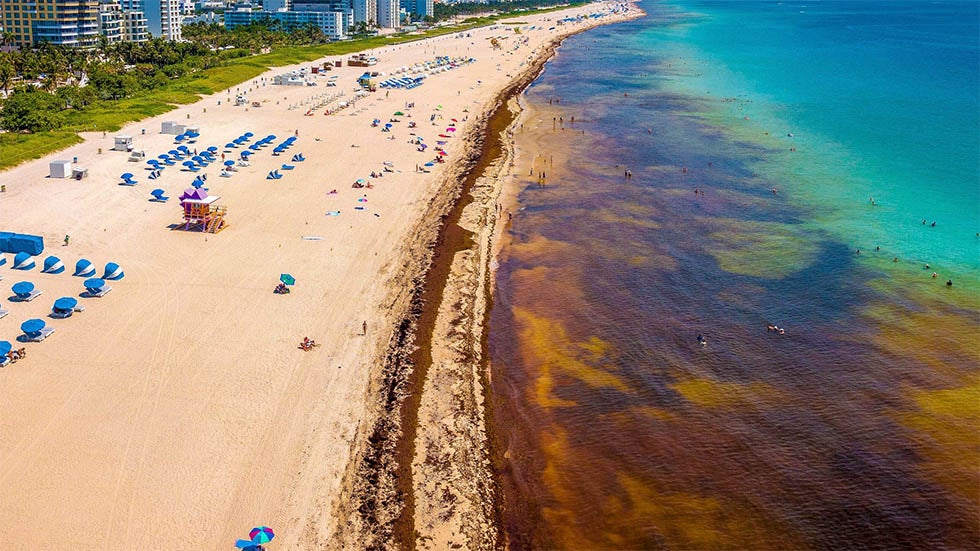Two-times U.S.-size Seaweed Swath Threatens Spring And Summer Tourism
Two-times-U.S.-size seaweed swath threatens spring and summer tourism. Sargassum seaweed is a natural occurrence in the ocean, but its excessive growth in recent years has been linked to climate change and pollution.
Author:Jane RestureMar 23, 202355K Shares821.9K Views

Two-times-U.S.-size seaweed swath threatens spring and summer tourism. Sargassum seaweed is a natural occurrence in the ocean, but its excessive growth in recent years has been linked to climate change and pollution.
Seaweed can affect the tourism industry by damaging beaches, creating a foul odor, and posing health risks to visitors.
The affected areas include popular tourist destinations such as Mexico, the Caribbean, and parts of Florida. Tourism is a significant source of revenue for these areas, and the seaweed could potentially harm the industry.
Local authorities are taking steps to mitigate the impact of the seaweed, such as cleaning the beaches and using barriers to prevent the seaweed from reaching the shore. However, it's uncertain how effective these measures will be in the long term.
Environmental Impacts
The excessive growth of Sargassum seaweed can have various environmental impacts. When the seaweed washes ashore, it can create a layer of organic matter that decomposes and releases nutrients into the water, leading to oxygen depletion and harmful algal blooms. This can have negative impacts on the marine ecosystem, causing fish kills and damaging coral reefs.
Additionally, the accumulation of Sargassum seaweed on beaches can block sunlight and prevent the growth of native vegetation, which can alter the habitat of nesting sea turtles and other wildlife.
In addition to environmental impacts, the presence of excessive amounts of seaweed can also impact local economies and communities. The tourism industry can be particularly vulnerable, as visitors may avoid beaches that are covered in seaweed, leading to lost revenue for hotels, restaurants, and other businesses that rely on tourism.
Moreover, the removal and disposal of large amounts of seaweed can be costly and challenging for local authorities, particularly in areas with limited resources. The use of heavy machinery to remove the seaweed can also damage the beach and create noise pollution that can disturb wildlife and visitors.
Overall, the excessive growth of Sargassum seaweed highlights the complex and interconnected nature of environmental issues and the need for a coordinated effort to address them.
Effects In Tourism
The presence of excessive amounts of Sargassum seaweed can have a significant impact on the tourism industry in affected areas. Some of the ways in which tourism can be affected include:
Reduced Beach Access
Large amounts of seaweed can make it difficult or impossible for visitors to access the beach, reducing the appeal of the area for tourists.
Negative Visual Impact
The presence of seaweed can make beaches appear unattractive and unappealing to visitors.
Bad Odor
As seaweed decomposes, it can produce a strong and unpleasant odor, which can be off-putting to visitors.
Negative Impact On Water Sports
The presence of seaweed can make it difficult or impossible for tourists to engage in water sports such as swimming, snorkeling, and diving.
Health Concerns
Seaweed can attract insects and other pests, leading to concerns about the potential spread of diseases and other health issues.
Clean-up Costs
Local authorities may need to spend significant amounts of money to remove the seaweed from beaches and dispose of it properly, adding to the economic impact of the problem.
The impact of Sargassum seaweed on the tourism industry can be significant, particularly in areas where tourism is a major source of income. It's important for local authorities to take steps to mitigate the impact of the seaweed and to communicate clearly with tourists about the issue to minimize the impact on the tourism industry.
Final Words
It's important to acknowledge the impact of climate change on our planet and take steps to reduce our carbon footprint to prevent similar occurrences in the future.

Jane Resture
Author
Since she embarked on her first world trip in 2002, Jane Resture spent the past decades sharing her personal journey and travel tips with people around the world. She has traveled to over 80 countries and territories, where she experienced other cultures, wildlife she had only read about in books, new foods, new people, and new amazing experiences.
Jane believes that travel is for everyone and it helps us learn about ourselves and the world around us. Her goal is to help more people from more backgrounds experience the joy of exploration because she trusts that travel opens the door to the greatest, most unforgettable experiences life can offer and this builds a kinder, more inclusive, more open-minded world.
Latest Articles
Popular Articles